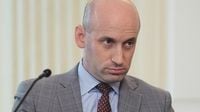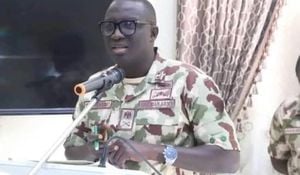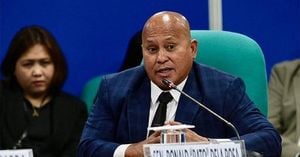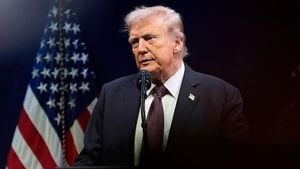On the afternoon of October 6, 2025, Stephen Miller, the White House deputy chief of staff, found himself at the center of a firestorm—one that began with an awkward pause on live television and has since ignited a fierce debate about presidential power, constitutional guardrails, and the specter of authoritarianism in America. The moment unfolded on CNN’s News Central, where Miller was invited to discuss President Donald Trump’s controversial deployment of National Guard troops to major U.S. cities, including Portland and Chicago. The interview, which was meant to clarify the administration’s stance amid mounting legal and political challenges, quickly spiraled into controversy and became emblematic of deeper anxieties gripping the nation.
According to TIME, Miller began the interview by confirming that the Trump administration had, that very morning, filed an appeal with the Ninth Circuit Court of Appeals, hoping to overturn a district judge’s order that blocked the deployment of the National Guard in Oregon. Miller then referenced a recent victory in the Ninth Circuit regarding the federalizing of the California National Guard, positioning the administration as emboldened by its legal momentum. But it was Miller’s next words that would echo far beyond the cable news studio. “Under Title 10 of the U.S. Code, the President has plenary authority, has—” Miller said, before abruptly freezing, blinking in silence as CNN anchor Boris Sanchez tried to regain control of the segment. The show quickly cut to a break, and when it returned, neither Miller nor Sanchez mentioned the phrase “plenary authority” again.
CNN later confirmed to TIME that a technical glitch had occurred: an audio feed from another channel had started playing in Miller’s in-ear monitor, causing the disruption. But on social media, speculation ran rampant. Some viewers suggested that Miller had realized, mid-sentence, that he was revealing more about the administration’s intentions than he should. One TikTok user commented, “Stephen Miller said the quiet part out loud accidentally and then appeared to glitch, all of a sudden when he recognized how much of his foot he just put into his mouth.” Another viral post on X claimed, “Stephen Miller didn’t glitch. He said ‘plenary authority’ and whoever was in his ear told him to STFU because he said too much and he froze like a deer in headlights.”
When the interview resumed, Sanchez pressed Miller about “the President’s legal authority as you see it under Title 10,” specifically asking whether the administration planned to abide by the judge’s order restricting National Guard deployments to Oregon. Miller responded, “Well, the Administration will abide by the ruling insofar as it affects the covered parties. But there are also many other options the President has to deploy federal resources and assets under the U.S. military to Portland. But I was making the point that under federal law, Section— Title 10 of the U.S. Code, the President has the authority anytime he believes federal resources are insufficient to federalize the National Guard to carry out a mission necessary for public safety.”
The legal foundation Miller referenced is not obscure. Title 10 of the U.S. Code does allow the President to call members of the National Guard into federal service under certain conditions: invasion by a foreign nation, rebellion or the threat of one, or if regular forces are unable to execute U.S. laws. But it is the invocation of “plenary authority”—a term defined by Cornell University’s Legal Information Institute as “power that is wide-ranging, broadly construed, and often limitless for all practical purposes”—that has set off alarm bells among legal scholars, politicians, and activists alike.
As Common Dreams reported on October 10, 2025, the controversy surrounding Miller’s remarks is not occurring in a vacuum. The Trump administration’s recent actions—deploying National Guard troops to cities like Chicago and Portland, escalating confrontations with protesters, and floating the possibility of invoking the 19th-century Insurrection Act—are seen by critics as part of a broader strategy to expand executive power and bypass constitutional constraints. The article draws striking parallels between Trump’s approach and the political philosophy of Carl Schmitt, the Nazi jurist who argued that “there is no law, only power,” and that a strong leader must transcend democratic norms in moments of crisis.
JD Vance, a prominent Trump ally, has openly quoted Schmitt, and billionaire Peter Thiel has reportedly been influenced by his ideas as well. According to Common Dreams, Schmitt’s doctrine teaches that a leader should use emergencies—real or manufactured—to justify the suspension of constitutional norms and the concentration of power in the executive. The article argues that Trump’s recent moves, from flouting laws like the Hatch Act to punishing political enemies while rewarding loyalists, mirror the steps Schmitt advocated for dismantling republics and installing authoritarian regimes.
Robert Reich, the former Labor Secretary, has outlined what he sees as a four-step plan by Trump to achieve “plenary power”: deploy ICE and National Guard troops to provoke unrest in Democratic-led cities, exaggerate the resulting crisis, escalate the federal response to justify further crackdowns, and finally invoke the Insurrection Act to suspend parts of federal law and the Constitution. Illinois Governor JB Pritzker and California Governor Gavin Newsome have both accused Trump of attempting to manipulate the upcoming 2026 and 2028 elections through these tactics. Pritzker has stated that the goal of the administration’s “invasion” is to “control and corrupt the elections,” a sentiment echoed by Newsome.
Despite the provocations, protesters in Portland, Los Angeles, and Chicago have largely resisted being drawn into violent confrontations. Instead, they have responded with creative forms of protest, from street theater to bike rides, even as tensions have flared—most notably when a priest was shot with a pepper ball round during a peaceful demonstration outside an ICE facility in Portland. Still, the threat of escalation looms. As Forbes and Common Dreams have noted, Trump has suggested he would not hesitate to invoke the Insurrection Act if courts or local officials stand in his way: “If people were being killed and courts were holding us up or governors or mayors were holding us up, sure, I’d do that,” Trump said, referring to the use of troops under the Act.
The debate is not limited to media pundits and political adversaries. In federal court in Chicago on October 9, 2025, U.S. Deputy Attorney General Eric Hamilton declared, “The president’s judgment is unreviewable,” a statement that many see as echoing Schmitt’s most dangerous ideas about unchecked executive power. Historian Heather Cox Richardson has warned that “exceptions to the rule of law reveal who is really in charge of the government,” connecting Miller’s use of the term “plenary” directly to Schmitt’s influence on segments of the American right.
As the nation watches protests unfold and legal battles intensify, the question remains: Are Americans witnessing the erosion of the constitutional order, or simply the latest skirmish in an era of hyper-partisan politics? For now, the administration’s claims of “plenary authority” and the specter of the Insurrection Act hang over the country like a storm cloud, threatening to redefine the very nature of American democracy.
In this moment, the stakes could hardly be higher, and the eyes of the nation—and the world—are fixed on what comes next.




